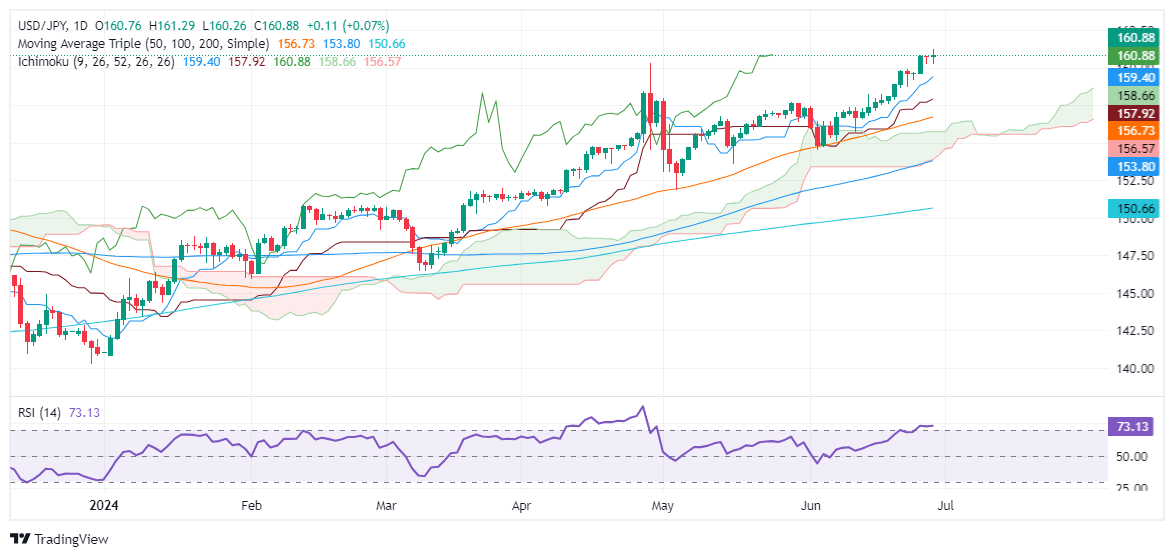- Phân tích
- Tin tức và các công cụ
- Tin tức thị trường
- USD/JPY Price Analysis: Extends gains near 161.00
USD/JPY Price Analysis: Extends gains near 161.00
- USD/JPY climbs to 160.89, up 0.08%, buoyed by strong US data and rising Treasury yields.
- Technicals show buyer momentum; RSI overbought but not extreme.
- Resistance levels: 161.00, 162.00, 164.87 (Nov 1986 high), 178 (Apr 1986 high).
- Support found at 159.19 (Tenkan-Sen), 158.75 (June 24 low), 158.65 (Senkou Span A), 157.91 (Kijun-Sen).
The USD/JPY extended its gains on Friday and is set to end the week with more than 0.50% gains after US economic data spurred a jump in the US Treasury, despite increasing speculations that the US central bank could cut rates in 2024. The USD/JPY trades at 160.89, up 0.08%.
USD/JPY Price Analysis: Technical analysis
The USD/JPY uptrend remains intact, though traders are cautious after reclaiming the psychological 160.00 level, which is viewed as the first line of defense for Japanese authorities to intervene in the FX markets. Despite this, the pair has continued to advance steadily, increasing intervention risks.
Momentum favors buyers, even though the Relative Strength Index (RSI) is overbought. However, due to the strength of the uptrend, many technicians consider 80 as the threshold for "extreme" overextended conditions.
The USD/JPY first resistance levels would be the psychological marks of 161.00, 162.00, and so forth, leading up to the November 1986 high of 164.87. Beyond that, the next significant resistance is the April 1986 high of 178.
Conversely, if USD/JPY drops below 160.00, the first support would be the Tenkan-Sen at 159.19, followed by the June 24 low of 158.75. Once those levels are cleared, the next support is the Senkou Span A at 158.65, followed by the Kijun-Sen at 157.91.
USD/JPY Price Action – Daily Chart
Japanese Yen FAQs
The Japanese Yen (JPY) is one of the world’s most traded currencies. Its value is broadly determined by the performance of the Japanese economy, but more specifically by the Bank of Japan’s policy, the differential between Japanese and US bond yields, or risk sentiment among traders, among other factors.
One of the Bank of Japan’s mandates is currency control, so its moves are key for the Yen. The BoJ has directly intervened in currency markets sometimes, generally to lower the value of the Yen, although it refrains from doing it often due to political concerns of its main trading partners. The current BoJ ultra-loose monetary policy, based on massive stimulus to the economy, has caused the Yen to depreciate against its main currency peers. This process has exacerbated more recently due to an increasing policy divergence between the Bank of Japan and other main central banks, which have opted to increase interest rates sharply to fight decades-high levels of inflation.
The BoJ’s stance of sticking to ultra-loose monetary policy has led to a widening policy divergence with other central banks, particularly with the US Federal Reserve. This supports a widening of the differential between the 10-year US and Japanese bonds, which favors the US Dollar against the Japanese Yen.
The Japanese Yen is often seen as a safe-haven investment. This means that in times of market stress, investors are more likely to put their money in the Japanese currency due to its supposed reliability and stability. Turbulent times are likely to strengthen the Yen’s value against other currencies seen as more risky to invest in.
© 2000-2024. Bản quyền Teletrade.
Trang web này được quản lý bởi Teletrade D.J. LLC 2351 LLC 2022 (Euro House, Richmond Hill Road, Kingstown, VC0100, St. Vincent and the Grenadines).
Thông tin trên trang web không phải là cơ sở để đưa ra quyết định đầu tư và chỉ được cung cấp cho mục đích làm quen.
Giao dịch trên thị trường tài chính (đặc biệt là giao dịch sử dụng các công cụ biên) mở ra những cơ hội lớn và tạo điều kiện cho các nhà đầu tư sẵn sàng mạo hiểm để thu lợi nhuận, tuy nhiên nó mang trong mình nguy cơ rủi ro khá cao. Chính vì vậy trước khi tiến hành giao dịch cần phải xem xét mọi mặt vấn đề chấp nhận tiến hành giao dịch cụ thể xét theo quan điểm của nguồn lực tài chính sẵn có và mức độ am hiểu thị trường tài chính.
Sử dụng thông tin: sử dụng toàn bộ hay riêng biệt các dữ liệu trên trang web của công ty TeleTrade như một nguồn cung cấp thông tin nhất định. Việc sử dụng tư liệu từ trang web cần kèm theo liên kết đến trang teletrade.vn. Việc tự động thu thập số liệu cũng như thông tin từ trang web TeleTrade đều không được phép.
Xin vui lòng liên hệ với pr@teletrade.global nếu có câu hỏi.
















